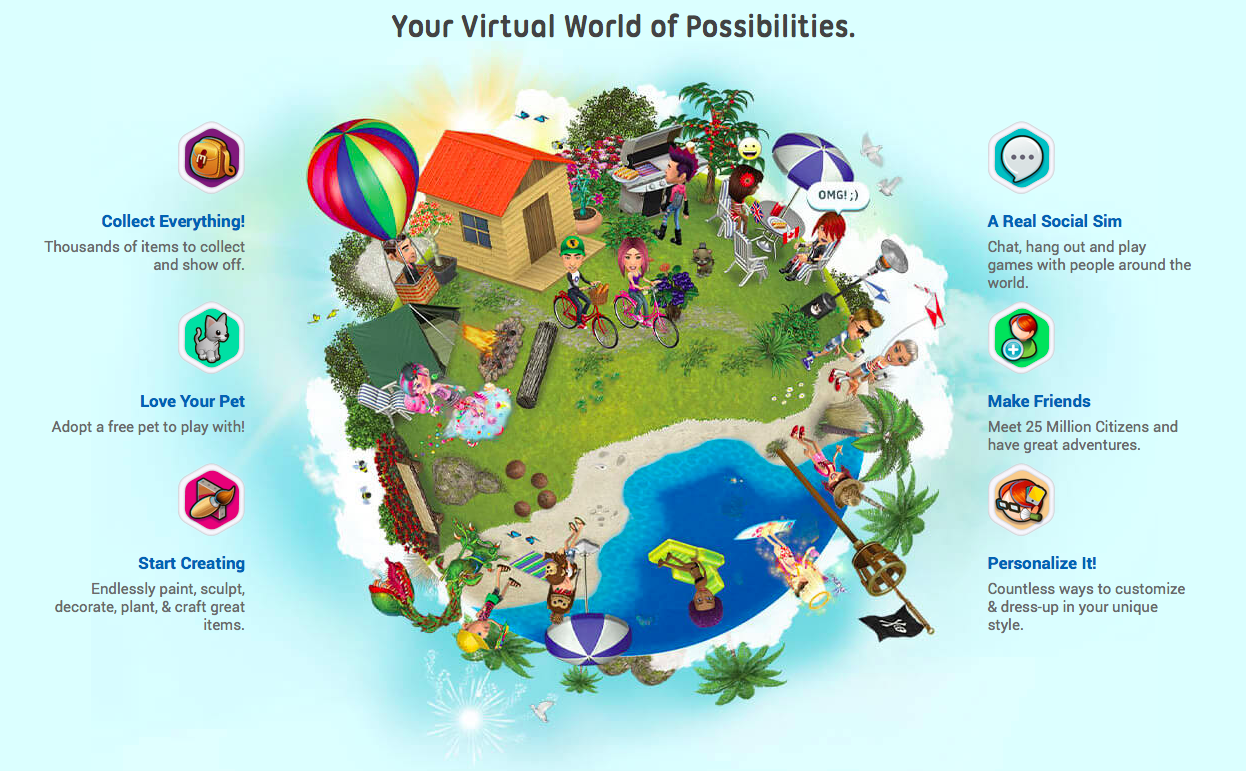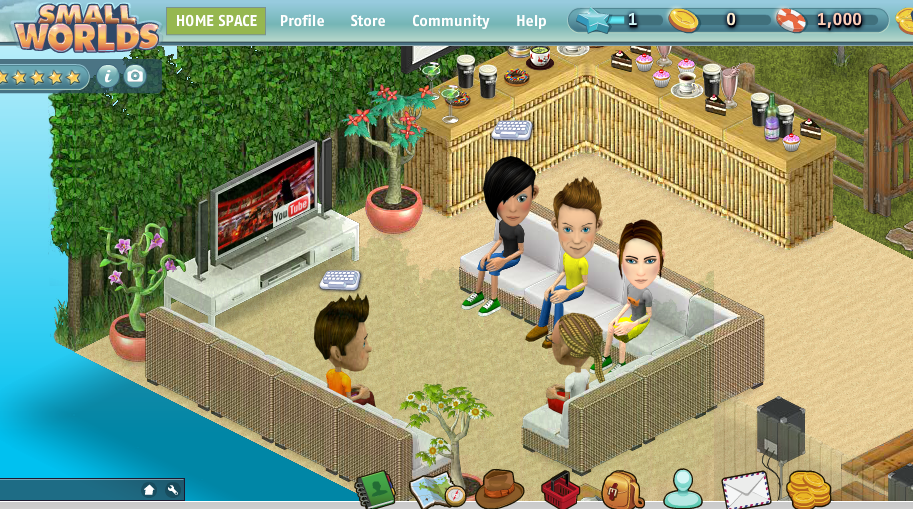
Reflection on: Using SmallWorlds to enhance social presence, group cohesion, and group identity in an online postgraduate course by Angelos Konstantinidis (2017)
Overview
This paper about virtual worlds reminds us that the current digitised and connected world is forcing educators to re-think the way in which they teach. On second thought, ‘force’ is a strong word here, and one that is more apt regarding those for which the digital revolution has suddenly crept up on them. For me, it has been somewhat different – I started off many years ago feasting on free online courses and MOOCs. Thus it was a natural progression to integrate technology with my teaching – (or is it the other way around?) – I wasn’t forced at all (nor am I an expert!).
I digress! This paper reminds us that having access anytime, anywhere to learning materials does not automatically make us learn. Indeed it is the very flexibility of this access which is the main drawback. And that motivation, structure and self-organisation need to be of higher importance and its application more rigid, in order to maximise the online learning process and enable online learners to acquire new knowledge.
F2F learning vs. Online learning
The benefits of face-to-face learning are clear – direct oral communication, visual cues to clarify meaning, a closed group working towards a common goal – all of this facilitates achieving learning outcomes. However, in the online learning environment these interactions need to be replicated and enhanced in order to achieve the same learning goal. One such way it may be replicated is through the adoption of Virtual Worlds, the affordances and barriers of which I blogged about in a previous post.
But here is a quick summary of the benefits of Virtual Worlds anyway (!):
- increases the users’ sense of being and communicating with other people in an immersive environment
- potential to foster teamwork and social interaction among students
- increases sense of group identity and strengthens group cohesion

SmallWorlds
This paper summarises the use of a virtual world called SmallWorlds to enhance social presence, group cohesion, and group identity in an online postgraduate course. My MA (in DTLT) has its own virtual space on/in SmallWorlds (SW). It is an open space with garden area and DJ equipment. A lounge with TV and buffet, a dance floor with a DJ set and a garden with campfire, wooden logs and sitting stones. Sounds fancy, huh? SW itself is 3D-like and has a lot of game features such as taking on individual or group missions. Indeed members use avatars to personify themlseves in the virtual environment. These avatars, or visual representations, can move, speak synchronously and asynchronously, and can perform a number of human gestures like smiling and laughing. They can even move things and buy things with SW’s own currency! Read more about my experience with avatars here.
Rationale for SmallWorlds
- easy access, average internet speed
- no installation
- movement controls quite intuitive, little technical knowledge required
Constructs defined
Social Presence (SP) – the extent to which one has a sense of ‘being’ and is able to communicate in an online environment.
SP practical ideas – exploit the text and audio functions to replicate and enhance the physical aspects of the learning experience allowing individuals to communicate and hear each other as they would in the traditional face-to-face-context.
Group Cohesion (GC) – social interaction with others, personal knowledge of them and interpersonal attraction towards them increases group cohesion.
GC practical ideas – Getting To Know You activities which allow participants to share experiences and learn about others, including those which allow the group to negotiate and establish group rules
Group Identity (GI) – being able to project one’s own identity into the group, feeling part of the group, having the same goals, understanding what sets the group aside from others.
GI practical ideas – Joint tasks where everyone plays a role and common goal setting, including where each participant has a chance to lead.

Strategies for enhancing social presence – VW course meetings & social meetings
From this reading I understood that using VWs for course meetings magnifies presence in a rich and authentic way. It’s very ‘3D’, that is, much more dimensional and life-like than a normal platform such as Moodle. It’s also very good for social interactions which are the first stepping stone towards building a sense of community. Perhaps you are even more comfortable here than you would be in the real-world, as you are tucked safely behind an avatar, it being the outward expression of you in the virtual world. Certain barriers that exist to you in the real-world are lifted, embarrassment of physical looks or lack of knowledge or even lack of cool identity. All of these inhibitions may be overcome through the adoption of an other persona/avatar.
Organising social meetings was another way in which social presence was enhanced on the SW platform. Indeed, as humans we are innately social beings who mostly thrive in social interactions. All research points to the value of social interactions – both online and offline. However, it is true that the focus on purely social interaction, that is, one without an academic purpose, in the online environment, is rare: “By not organising or supporting purely social gatherings it seems that online programmes waste an opportunity in their effort to enhance students’ sense of social presence and develop interpersonal relationships with their peers” (p8).
Something new: Nurturing a democratic environment in online learning
Towards the end of the paper I came across something new – the idea of learning being a democratic process, and it is a bold concept I greatly admire. The author lists the democratic environment as one where:
- all members are treated as equals
- respect is upheld for all members
- members have a responsibility for their learning and the learning of the group
- members are encouraged to acquire the role of the teacher
It’s the last point that I have the fondest memories, especially on the Technology-Enhanced Creative Writing (TECW) module where there was a lot of peer interaction and we all took turns taking the lead and steering the discussion. Read more about my TECW adventures here.
My Suggestions
Of course, virtual worlds are not without a downside. It requires a lot of planning and organising, one must forecast and prepare for technical issues in advance and be prepared for some resistance. However, overall, and having has this experience myself, I would say we could have had more meetings on the SW platform during the Masters course – perhaps once a month – especially with the part its plays in enhancing social presence. I really do see the value in learning by doing, and, although the platform is not difficult to use it would be good to have a set time to get to know the tools and practise using them on a more regular basis in order to internalise the functionality. In fact the author confirms his desire to further exploit the affordances of SmallWorlds in the future, which will allow teacher participants to become more comfortable in the environment and gain practical skills.
Reference
Konstantinidis, A., (2017). Using SmallWorlds to Enhance Social Presence, Group Cohesion, and Group Identity in an Online Postgraduate Course. In Handbook of Research on Collaborative Teaching Practice in Virtual Learning Environments. PA: IGI Global, 2017. N. pag. Print.
Image Sources
My own screenshots from www.smallworlds.com
Meeting by Samuel Zeller from www.unsplash.com
